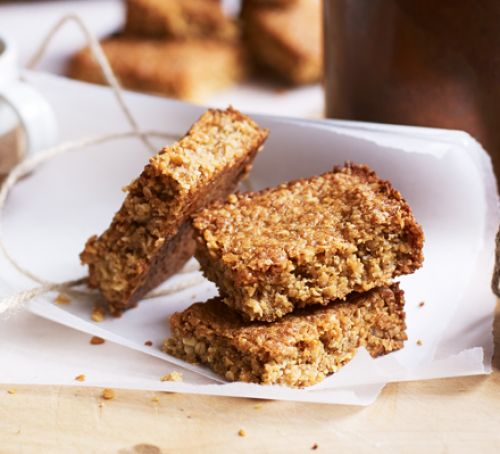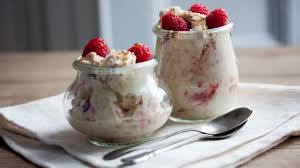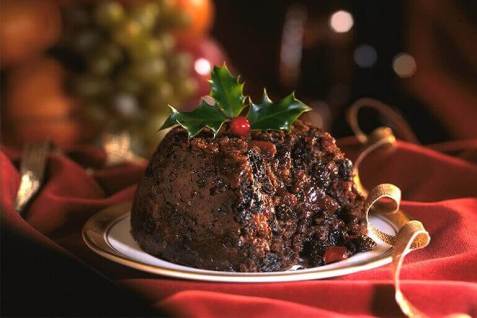Most countries have some national and regional dishes that can’t be found anywhere else and can raise some eyebrows because of their names, origins and ingredients. So, just for fun, we thought we’d highlight some of the strange and peculiarly British cuisine dishes that are available.
Firstly, one point to remember is that the term “Pudding” in Britain, does not refer to the Jello Pudding mix that is common in the USA. “Pudding” is in fact, the English generic term for dessert — covering not only creamy concoctions, but also cakes, pies, biscuits (cookies), mousse, ice cream … you name it. However, as in the case of Yorkshire Pudding, which is not a dessert at all, the term pudding may also refer to a savory pudding….So, beware! A British “Pudding” may not be what you think……..
YORKSHIRE PUDDING
Not a pudding at all, but a light savory batter of milk, eggs and flour. Traditionally served with roast beef, roast potatoes and vegetables with gravy. Some will serve the dinner IN the plate sized Yorkshire Pudding and some will served miniature (muffin sized) Yorkshire Puddings, they’re kind of like popovers, with the meal. It used to be served with just gravy, prior to the main meal as a filler, so that the more expensive, meat part of the meal would go further. However you have it, it’s a little piece of British Heaven on a plate.
TOAD IN THE HOLE

No, not a toad in a, well, or hole but sausages cooked in Yorkshire Pudding. Which, even more confusingly, as mentioned above, isn’t pudding. Anyway, the main thing is it’s delicious — especially with thick onion gravy
PIGS IN BLANKETS

Unlike American Pigs in Blankets (which are more like British Sausage Rolls), sausages (the ‘pigs’) are wrapped in bacon (the ‘blankets’) and cooked, often as complement to a roast meat dish.
SAUSAGE ROLLS

These are sausages that are wrapped in either puff or shortcrust pastry and usually served as part of a buffet. Equally delicious served warm from the oven or when cooled down.
BANGERS AND MASH

Yet another sausage dish, this time served with mashed potato and gravy. Bangers are so-called, because after the First World War there was little meat in sausages — just scraps, cereal and water — so they sizzled and spluttered a lot when they were frying. It sounded as if there were mini explosions, or bangs, going on, hence the name bangers
BEDFORDSHIRE CLANGER

Traditionally a suet pudding pastry hand-held pie with a mix of sweet and savory flavors (the sweet sits in one end and the savory on the other). It was a staple meal for workers laboring in the fields as it was easily transportable and carried both a main course and a pudding in one pastry. In old recipes the sweet would be some sort of jam and the savory would be chopped up beef skirt or minced pork.The Clanger is very similar in its history to the Cornish pasty.
CORNISH PASTY

The pasty has been a documented part of the British diet since the 13th Century, at this time being devoured by the rich upper classes and royalty. The fillings were varied and rich; venison, beef, lamb and seafood like eels, flavored with rich gravies and fruits. It wasn’t until the 17th and 18th centuries that the pasty was adopted by miners and farm workers in Cornwall as a means for providing themselves with easy, tasty and sustaining meals while they worked. And so the humble Cornish Pasty was born.
The wives of Cornish tin miners would lovingly prepare these all-in-one meals to provide sustenance for their spouses during their grueling days down the dark, damp mines, working at such depths it wasn’t possible for them to surface at lunchtime. A typical pasty is simply a filling of choice sealed within a circle of pastry, one edge crimped into a thick crust . A good pasty could survive being dropped down a mine shaft! The crust served as a means of holding the pasty with dirty hands without contaminating the meal. Arsenic commonly accompanies tin within the ore that they were mining so, to avoid arsenic poisoning in particular, it was an essential part of the pasty.
BUBBLE AND SQUEAK

Again, a great name for something that’s less glamorous, in this case fried leftovers of a roast meal. Popular during the rationing of World War 2, it’s still a popular way of cooking the leftover potatoes and other vegetables from a traditional English roast dinner. The name came about because the cabbage and potatoes would bubble and squeak in the pan while they were cooking.
STARGAZY PIE

Quite a sinister looking dish, this offering is from Cornwall in South West England. It’s a fish pie with the fish heads (usually Mackerel) stuck onto the crust (‘staring’ at the stars). The reason behind this rather odd presentation is one rooted in practicality; juices and oils from the heads drain back into the pie while it is being cooked, keeping the pastry moist.
ANGELS & DEVILS ON HORSEBACK
The ‘posh’ version of pigs in blankets: oysters wrapped in bacon. ‘Devils On Horseback’ are prunes wrapped in bacon. All 3 are usually served as sides to a large roasted dinner.
FISH AND CHIPS WITH MUSHY PEAS

Fish and Chips is very much a British tradition. Probably the most common takeout restaurant in the UK is the Fish and Chip Shop or Chippy. Though they offer many other delicacies too including Kebabs (Kabobs), Pies (Savory), Burgers, Chicken and sausages, fish and chips is still the favored selection. Mushy peas are dried marrowfat peas which are first soaked overnight in water with sodium bicarbonate, then rinsed in fresh water boiled and then mashed with salt, pepper and a little sugar until they form a thick green lumpy mash. They are a popular British accompaniment to fish and chips.
SCOTCH EGGS

A Scotch egg consists of a soft-boiled egg wrapped in sausage meat, coated in bread crumbs and baked or deep-fried.
BLACK PUDDING

Black pudding is a type of blood sausage originating in Great Britain and Ireland. It is made from pork blood, pork fat or beef suet and a cereal, usually oatmeal, oat groats or barley groats. Although it is produced by several large national companies, local butchers will often make their own versions. More commonly, it is served as part of a full cooked breakfast.
PICCALILLI

A yellow pickle relish made from cauliflower, courgettes (zucchini), and other vegetables, pickled with vinegar, salt, sugar, and spiced with mustard, turmeric, and other spices. It would be served with a plate of cold meats and cheeses.
PORK PIE

A pork pie is a traditional British cold meat pie. It consists of roughly chopped pork and pork jelly sealed in a hot water crust pastry. It is normally eaten as a snack or with a salad.
CULLEN SKINK

This rich soup of smoked haddock, potatoes, onions and milk was born in the fishing town of Cullen. In the late 1800s, when both money and produce were in short supply, fisher wives came up with the idea of using smoked haddock instead of shin of beef as the key ingredient in broth. The soup is now considered a luxurious delicacy and is served in restaurants all over the world.
MULLIGATAWNY SOUP

Mulligatawny is a traditional British curried soup of Indian origin. There are many, many variations on the theme, but basically it is a curried chicken soup made with coconut milk, vegetables, rice, carrots, potatoes…the list goes on.
RUMBLEDETHUMPS

Rumbledethumps is a traditional dish from the Scottish Borders. The main ingredients are potato, cabbage and onion. Similar to Irish Colcannon, and English Bubble and Squeak, it is either served as an accompaniment to a main dish or as a main dish itself.
SCOUSE

It is a traditional seaman’s dish which may be of Viking origin. Labscaus or Lobscouse, is made with corned beef, onions, and mashed potatoes and flavored with a pinch of cumin and sometimes served with a fried egg on top. Pickled beets are a popular accompaniment.
HAGGIS
Haggis is Scotland’s national dish and the crowning glory of a traditional Burns Supper, and although it’s an object of Scottish culinary fascination around the world, it certainly is not a beauty queen. This enduringly popular dish is a type of savory pudding that combines offal (heart, kidneys, lungs of a sheep) with oatmeal, onions, salt and spices. Often served with the classic sides of bashed neeps and mashed tatties (that’s Scots for turnip and potatoes), haggis is traditionally cooked in a sheep’s stomach (a historic way of preserving meat), but most haggis nowadays is sold and cooked in a synthetic sausage casing. We agree that it may not win the title of the most elegant dish on the planet, but it really is undeniably delicious!
FAGGOTS

A dish made from meat off-cuts and offal minced together with herbs and bread crumbs so that it holds its shapes. Faggots originated as an inexpensive food in the mid 19th century. The first use in print cited in the Oxford English Dictionary is in 1851, from Thomas Mayhew, where he describes a dish identical to the modern product with chopped liver and lights in an outer wrapper of caul fat (also known as lace fat, it is the thin membrane which surrounds the internal organs of some animals, such as cows, sheep, and pigs). Faggots are also known as savory ducks in the Midlands, Yorkshire, Lincolnshire and Lancashire
KIPPERS

A kipper is a whole herring (a small, oily fish), that has been split in a butterfly fashion from tail to head along the dorsal ridge, gutted, salted or pickled, and cold-smoked over smoldering wood chips.
STEAK AND KIDNEY PUDDING
Another savory ‘pudding’, this time made from suet pastry lining a bowl, filled with cubed beefsteak, beef kidneys, onion and gravy then steamed for several hours.
KEDGEREE

This is an Anglo-Indian dish that became popular throughout the United Kingdom and in Ireland in Victorian times as a result of the expansion of the British Empire. The name derives from the Hindi “Khichdi”, meaning a kind of rice and lentil dish. It is thought of as a breakfast dish, but makes a good light lunch, too. The ingredients can vary, but generally include rice, flaked smoked fish, chopped boiled eggs, onion and curry spices. Is generally served for a “posh” breakfast, but can be served as a light lunch.
PEASE PUDDING

The “pease” refers to peas. During the Middle Ages and beyond, in Britian, this pudding would have been cooked in a large cauldron that continually hung over the fire. Pease pudding is a traditional British dish to this day, even available in cans, although it is no longer made over a fire in a huge cauldron.
LANCASHIRE HOTPOT

Lancashire hotpot is a stew originating from Lancashire in the North West of England. It consists of lamb or mutton and onion and carrots topped with sliced potatoes and baked in a heavy pot on a low heat.
LEMON POSSET OR SYLLABUB
Posset and Syllabub have been enjoyed for centuries though it used to be served as a warming drink to encourage slumber. Both are made by curdling milk with alcohol or citrus juices, though syllabub tended to be thicker. However, nowadays they are both more like a citrussy fool than a frothy drink.
JAM ROLY POLY

Another 19th century pudding, Jam Roly-Poly features in Mrs Beeton’s cookbook and is considered a classic British dessert. A flat-rolled suet pudding which is spread with jam and rolled up, like a Swiss roll, then steam or baked. Traditionally served with hot custard.
Other names for the pud include dead man’s arms, dead man’s leg or shirt-sleeve pudding as it was often steamed and served in an old shirt-sleeve.
SWISS ROLL

Swiss Roll is a light (usually fate-free) sponge cake with a filling such as jam, cream, or lemon curd. It is cooked in a flat rectangular tray and then rolled into a log shape, and has a spiral pattern when sliced.
BATTENBURG CAKE

Battenberg is a light sponge cake with the pieces covered in jam. The cake is covered in marzipan and, when cut in cross-section, displays a distinctive two-by-two check pattern alternately colored pink and yellow.
SPOTTED DICK

No sniggering at the back of the class there… This is a traditional English pudding consisting of steamed sponge cake containing currents or sultanas (the ‘spots’), usually served with custard. The first recipe for Spotted Dick appeared in 1849 in Alexis Soyer’s The modern Housewife or ménagère.
TREACLE TART

In Britain, treacle is a word applied to all sugary sticky syrups, from the dark, almost black sticky molasses to golden syrup, which is lighter in character and in color, and an essential component of their beloved treacle tart. Inside a buttery shortbread crust, a molten goo of golden syrup drowns bread crumbs and lemon zest. With little else than an egg whisked with cream to set the center, its very simplicity is its ultimate strength.
FLAPJACK

Unlike in the USA where a flapjack is another term for pancake, in the UK, a flapjack is pretty much a soft-baked granola bar, cooked in a flat oven tin and cut into rectangles. Made from rolled oats, fat (typically butter), brown sugar and usually golden syrup ( a light version of molasses).
PARKIN

Parkin or Perkin, originating in northern England, is a gingerbread cake traditionally made with oatmeal and black treacle (molasses).
TRIFLE

Trifle in English cuisine is a dessert made with fruit, a thin layer of sponge cake fingers soaked in fruit juice (or sherry or another fortified wine), and custard. It can be topped with whipped cream and slivered almonds. More modern trifles will use jelly (jello), but it is not part of the traditional recipe.
ECCLES CAKES

An Eccles cake is a small, round cake made from buttery flaky pastry, filled with currants sometimes topped with sugar.
ETON MESS

Eton mess is a traditional English dessert consisting of a mixture of strawberries, broken meringue, and whipped double cream.
CRANACHAN

Originally a summer dish, Cranachan is a traditional Scottish dessert usually made from a mixture of whipped cream, whisky, honey and fresh raspberries with toasted oatmeal.
ENGLISH CRUMPETS

A crumpet is a small griddle cake made from an unsweetened batter of water or milk, flour and yeast, eaten in the United Kingdom. Toasted and eaten hot with slatherings of butter.
SCOTTISH CRUMPETS

These are not spongy and chewy like English Crumpets but are thinner and wider, more like American pancakes, though one side is smooth while the other is full of holes (imagine an unflipped American pancake).
SUSSEX POND PUDDING

Sussex pond pudding, or well pudding, is a traditional English pudding from the southern county of Sussex. It is made of a suet pastry, filled with butter and sugar, and is boiled or steamed for several hours. Modern versions of the recipe often include a whole lemon enclosed in the pastry.
ECCLEFECHAN TARTS

Named after the town of Ecclefechan in the Scottish Borders, these delicious all butter pastry tarts are filled with the finest ingredients – sultanas, cherries and almonds.
BLACK BUN

Black bun is a type of dark fruit cake completely covered with pastry. It is Scottish in origin, originally eaten on Twelfth Night but now enjoyed at Hogmanay.
TABLET

NO! Not an electrical device, nor is it a medication. Tablet is a medium-hard, sugary confection from Scotland. Like Fudge, Tablet is usually made from sugar, condensed milk, and butter, which is boiled to a soft-ball stage however, unlike like fudge which remains creamy in consistency, Tablet is cooked longer and allowed to crystallize.
CHRISTMAS PUDDING

Christmas pudding (sometimes called figgy pudding or plum pudding) is a cake-like dish made during the holidays. Classic Christmas puddings feature copious amounts of dried fruits. The British Christmas pudding dates back to the Medieval times, but they became most popular in the Victorian era when cooks learned to preserve dried fruits and meats for the winter months. The meats and fruits were combined to create mince pies, which were the precursor to Christmas puddings.
Pudding recipes combine all types of dried fruits, among them raisins, figs, prunes and glacé fruits, as well as citrus zest and nuts. Eggs, breadcrumbs and suet (beef or mutton fat from around the kidney) helps hold the mixture of fruits and nuts together. It is then pressed into a bowl, covered with parchment, and steamed in a pot on the stove for hours and hours until cooked.
MINCE PIES

Like the Christmas Pudding, Mince Pies are a quintessential part of British Christmas celebrations. Its ingredients are traceable to the 13th century, when returning European crusaders brought with them Middle Eastern recipes containing meats, fruits and spices. The early mince pie was known by several names, including “mutton pie”, “shrid pie” and “Christmas pie”. Typically its ingredients were a mixture of minced meat, suet, a range of fruits, and spices such as cinnamon, cloves and nutmeg. Today the mince pie is filled with a mixture of dried fruits and spices called “mincemeat” but now without meat (but often including suet or other animal fats), remains a popular seasonal treat enjoyed by many across the United Kingdom and Ireland.
SUMMER PUDDING

Summer pudding or summer fruit pudding is a British dessert made of stale sliced white bread, layered in a deep bowl with fruit and fruit juice. It is left to soak and set overnight and turned out onto a plate with fruit and cream to serve.
VICTORIA SPONGE CAKE

The Victoria Sponge (or sandwich) is a sponge cake sandwiched together with raspberry jam and dusted on the top with caster sugar. It is a quintessential English teatime treat and became popular during the reign of Queen Victoria. The ingredients in a traditional Victoria Sponge are eggs, flour, sugar, and butter and should be of equal weight; the eggs are weighed in their shell. There are a number of Victoria Sponge variations including using strawberry jam instead of raspberry; adding buttercream or whipped double cream instead of just jam; and dusting the top with icing sugar rather than caster sugar.
QUEEN OF PUDDINGS

Queen of Puddings is a traditional British dessert, consisting of a baked, breadcrumb-thickened mixture, spread with jam and topped with meringue










